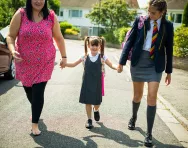Important update from TheSchoolRun
For the past 13 years, TheSchoolRun has been run by a small team of mums working from home, dedicated to providing quality educational resources to primary school parents. Unfortunately, rising supplier costs and falling revenue have made it impossible for us to continue operating, and we’ve had to make the difficult decision to close. The good news: We’ve arranged for another educational provider to take over many of our resources. These will be hosted on a new portal, where the content will be updated and expanded to support your child’s learning.
What this means for subscribers:
- Your subscription is still active, and for now, you can keep using the website as normal — just log in with your usual details to access all our articles and resources*.
- In a few months, all resources will move to the new portal. You’ll continue to have access there until your subscription ends. We’ll send you full details nearer the time.
- As a thank you for your support, we’ll also be sending you 16 primary school eBooks (worth £108.84) to download and keep.
A few changes to be aware of:
- The Learning Journey weekly email has ended, but your child’s plan will still be updated on your dashboard each Monday. Just log in to see the recommended worksheets.
- The 11+ weekly emails have now ended. We sent you all the remaining emails in the series at the end of March — please check your inbox (and spam folder) if you haven’t seen them. You can also follow the full programme here: 11+ Learning Journey.
If you have any questions, please contact us at [email protected]. Thank you for being part of our journey it’s been a privilege to support your family’s learning.
*If you need to reset your password, it will still work as usual. Please check your spam folder if the reset email doesn’t appear in your inbox.
7 vital road safety skills you must teach your child

Standing on the pavement waiting to cross the road can be a nerve-wracking experience with young children, and you wouldn’t be the only parent to have nightmares about your child wriggling away from your grasp (if you can convince them to hold your hand at all!) or standing just that bit too close to the edge of the kerb.
Becoming road-savvy is a key life skill for primary school children, though. By making sure your child knows how to recognise dangerous situations and understand their responsibility as a pedestrian, you can help them gain the confidence they need to stay safe on the roads as they get older.


Start a unique learning programme!
- Weekly programme for each school year
- Worksheets sent direct to your inbox
- Keeps your child's learning on track
Pedestrian support charity Living Streets organises Walk to School Month, and recommends that children learn these seven safety skills on their walk to school:
1. How to cross the road safely at each of the different crossing points on the journey. (Set a good example by always using designated crossing points when you walk together.
2. How to navigate using key landmarks – this will give them confidence when they start to walk alone, or with friends, on the journey to school.
3. How to be streetwise and watch for dangerous situations – pay attention to how your child follows road safety rules.
4. How be aware of problems on the route to school, and to tell you about them – this includes a crossing not working properly, a badly cracked pavement or speed limits being broken. Check these out yourself, and then report them to your local council if necessary.
5. How to cross by the school gates – there may be car congestion in this area when other children are being dropped off or picked up. Ask your school about setting up a ‘car free zone’ around the school gates.
6. How to be extra careful when crossing the road – research shows that primary-school-aged children are unable to accurately judge the speed at which cars are travelling, so make sure that they know not to take risks by waiting for green lights and allowing plenty of crossing time if they are not at a pedestrian crossing.
7. How to gain independence and confidence by walking on their own – doing this once they’re old enough will help reinforce the road safety skills they’ve learned.
Read more about the benefits of walking to school and getting your kids into walking activities.








